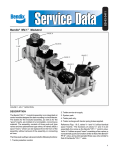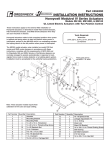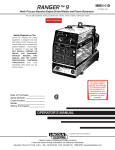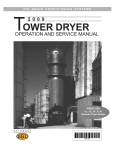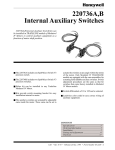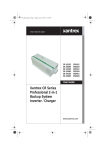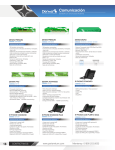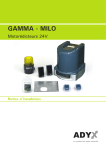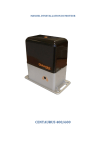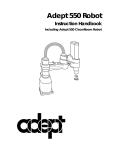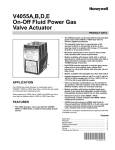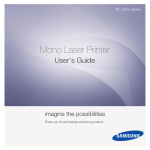Download Greenheck Fan Modutrol IV Motors 41 User's Manual
Transcript
Series 41 and 81 Modutrol IV™ Motors PRODUCT DATA FEATURES • Used to replace M445, M845 and M865 motors. • Models rated for 25 lb.-in. or 60 lb.-in. torque. • Integral spring return returns motor to normal position (open or closed) when power is interrupted. • Oil immersed motor and gear train for reliable performance and long life. • Wiring box provides NEMA 3 weather protection. • Motor operates from 24 Vac. Models are available with factory installed transformer, or an internal transformer can be field added. • Quick-connect terminals are standard—screw terminal adapter is available. • Adapter bracket for matching shaft height of older motors is standard with TRADELINE motors. • TRADELINE motors have field adjustable stroke (90° to 160°). APPLICATION The Series 41 and Series 81 Modutrol IV Motors are 2-position (line- and low- voltage, respectively) spring-return motors. They are used to operate dampers or valves in applications where it is necessary or desirable to have the controlled element return to the starting position in the event of power failure or interruption. • Die-cast aluminum housing. • Motors are designed for either normally open or normally closed valves and dampers. • Integral auxiliary switches are available factory mounted, or can be field added to TRADELINE models. • TRADELINE motors may operate valve linkages from the power end or auxiliary end shafts for normally closed or normally open valve applications. Contents Application ........................................................................ 1 Features ........................................................................... 1 Specifications ................................................................... 2 Ordering Information ........................................................ 2 Installation ........................................................................ 4 Settings and Adjustments ................................................. 7 Operation and Checkout .................................................. 10 Replacement .................................................................... 11 ® U.S. Registered Trademark Copyright © 2000 Honeywell • All Rights Reserved 63-2187-3 SERIES 41 AND 81 MODUTROL IV™ MOTORS SPECIFICATIONS Models: TRADELINE models are selected and packaged to provide ease of stocking, ease of handling and maximum replacement value. TRADELINE model specifications are the same as those of standard models unless specified otherwise. TRADELINE models have auxiliary switch cams. Modutrol IV Order Number Guide: See Table 1. Dimensions: See Fig. 1. Crankshaft: 3/8 in. (9.5 mm) square. Electrical Ratings: See Table 2. NOTE: Auxiliary switches can only be added to motors that include auxiliary switch cams. (These cams cannot be field-added.) Controller Type: Two wire, on-off switching action. Auxiliary Switch Ratings: See Table 3. Table 1. Series 41 and Series 81 Modutrol IV Order Number Guide. M M Motor 41 Series 41, line voltage, two-position control 81 Series 81, low voltage, two-position control 81 7 25 lb-in. torque 8 60 lb-in. torque 8 2 Normally Closeda Spring Return, single-ended shaft 5 Normally Closeda Spring Return, dual-ended shaft 6 Normally Openb Spring Return, dual-ended shaft 5 A 0 Auxiliary Switches B 1 Auxiliary Switch C 2 Auxiliary Switches D 0 Auxiliary Switch E 1 Auxiliary Switch F 2 Auxiliary Switches G 0 Auxiliary Switch H 1 Auxiliary Switch J 2 Auxiliary Switches K 0 Auxiliary Switch L 1 Auxiliary Switch M 2 Auxiliary Switches A XXXX Fixed Stroke Normally Closeda Adjustable Stroke Fixed Stroke Normally Openb Adjustable Stroke See Catalog for Complete O.S. Number a Electrically normally closed. Shaft rotates clockwise (viewed from the power end) with control signal increase. Motor drives to normally closed position when powered with control wiring not connected. b Electrically normally open. Shaft rotates counter-clockwise (viewed from the power end) with control signal increase. Motor drives to normally open position when powered with control wiring not connected. ORDERING INFORMATION When purchasing replacement and modernization products from your TRADELINE® wholesaler or distributor, refer to the TRADELINE® Catalog or price sheets for complete ordering number. If you have additional questions, need further information, or would like to comment on our products or services, please write or phone: 1. Your local Home and Building Control Sales Office (check white pages of your phone directory). 2. Home and Building Control Customer Relations Honeywell, 1885 Douglas Drive North Minneapolis, Minnesota 55422-4386 (800) 328-5111 In Canada—Honeywell Limited/Honeywell Limitée, 35 Dynamic Drive, Scarborough, Ontario M1V 4Z9. International Sales and Service Offices in all principal cities of the world. Manufacturing in Australia, Canada, Finland, France, Germany, Japan, Mexico, Netherlands, Spain, Taiwan, United Kingdom, U.S.A. 63-2187—3 2 SERIES 41 AND 81 MODUTROL IV™ MOTORS TOP VIEW TOP VIEW OF BRACKET 4-7/8 (124) 4-1/4 (107) 5-1/2 (140) 4-5/8 (116) 5-13/16 (148) 2-5/16 (58) 11/16 (17) 1/4 (7) 4 POWER END 13/16 (20) 3 4-1/16 (103) 1/4 (7) 1-1/2 (37) 4-7/8 (124) 4-1/16 (103) 5-9/16 (141) WIRING BOX BASE MOTOR 6-7/16 (164) 1 AUXILARY END POWER END 5-3/8 (137) 2-9/16 (66) 9/16 (15) 2 ADAPTER BRACKET 3/4 (19) 1 SOME MODELS DO NOT HAVE AN AUXILIARY SHAFT. ALL OTHER DIMENSIONS ARE THE SAME. 2 FOR HIGH TORQUE (60 LB-IN.) SPRING RETURN MODELS 8-3/4 (222); FOR LOW TORQUE (25 LB-IN.) SPRING RETURN MODELS 8-1/4 (210). 3 FOR HIGH TORQUE (60 LB-IN.) SPRING RETURN MODELS (SHOWN). 4 FOR LOW TORQUE (25 LB-IN.) SPRING RETURN MODELS. M17711 Fig. 1. Series 41 and Series 81 Modutrol IV Motor mounting dimensions in in. (mm). Dead Weight Load On Shaft (maximum): Power or Auxiliary End: 200 lb. [90.8 kg]. Combined Load: 300 lb. [136 kg]. (Dual-stroke motors only.) Maximum Damper Rating [B Dimension]: 25 lb.-in. Models: 68 in. 60 lb.-in. Models: 34 in. NOTE: The B dimension is the length of the damper side perpendicular to the drive shaft. Ambient Temperature Ratings: Maximum: 150°F (66°C). Minimum: -40°F (-40°C). Torque and Timing: See Table 4. Approvals: Underwriters Laboratories Inc. Listed: File No. E4436, Guide No. XAPX. Canadian Standards Association Certified: General listed File No. LR1620, Guide No. 400-E. 3 Accessories: 198162AA Internal Transformer; 120/208/240 Vac 50/60 Hz primary, 24 Vac secondary. 198162EA Internal Transformer; 120 Vac 50/60 Hz primary, 24 Vac secondary. 198162GA Internal Transformer; 220 Vac 50/60 Hz primary, 24 Vac secondary. 198162JA Internal Transformer; 24 Vac 50/60 Hz primary, 24 Vac secondary (for electrical isolation). 220736 Internal Auxiliary Switch Kit can be field-installed on TRADELINE models. One- (220736A) and Two(220736B) switch kits available. 220738A Adapter Bracket raises motor shaft height by 19 mm to match that of previous Modutrol® Motor models. 220741A Screw Terminal Adapter converts the standard quick-connect terminals to screw terminals. 221455A Infinitely Adjustable Crank Arm approximately 0.75 in. shorter than the 4074ELY Crank Arm, can rotate through downward position and clear motor base without requiring adapter bracket. 4074ERU Weatherproofing Kit provides NEMA 3 rating for Modutrol IV Motors mounted in position other than upright. 63-2187—3 SERIES 41 AND 81 MODUTROL IV™ MOTORS Accessories (continued): 4074EZE Bag Assembly with parts to provide CE compliance. 7617ADW Crank Arm approximately 0.75 in. shorter than 7616BR Crank Arm. Can rotate through downward position and clear motor base without requiring adapter bracket. ES650-117 Explosion-Proof Housing encloses motor for use in explosive atmospheres. Not for use with Q5001 (or any other valve linkages). Order separately from O-Z/Gedney Inc. To order, contact: O-Z/Gedney, Nelson Enclosures and Controls, (918) 641-7381 or (918) 641-7374; or write to: O-Z/Gedney, Nelson Enclosures and Controls P.O. Box 471650 Tulsa, OK 74147-1650 Requires Honeywell 7617DM Coupling. Q100 Linkage connects Modutrol® motor to V51 Butterfly Valve. Requires the 220738A Adapter Bracket (packed with TRADELINE Modutrol IV motors). Q5001 Bracket and Linkage Assembly connects Modutrol motor to a water or steam globe valve. Q605 Damper Linkage connects motor to damper. Includes motor crank arm. Q607 External Auxiliary Switch controls auxiliary equipment as a function of motor position. Table 2. Electrical Ratings. Voltage (at Current Power Consumption 50/60 Hz) Draw (A) (VA) (W) Without 24 Transformer 0.86 21 20 With Internal 24 Transformer 120 1.25 30 25 208 0.14 240 0.13 0.25 120 V 7.2 3.6 Locked Rotor 43.2 21.6 VA pilot duty, 120/240 Vac on opposite contact. Timing (sec.) 90° Stroke 30 160° Stroke 60 Other models 60 (6.8) 63-2187—3 3. 4. CAUTION Electrical Shock or Equipment Damage Hazard. Can shock individuals or short equipment circuitry. Disconnect all power supplies before installation. Motors with auxiliary switches can have more than one disconnect. CAUTION CAUTION Table 4. Torque and Timing. 25 (2.8) 2. Read these instructions carefully. Failure to follow them could damage the product or cause a hazardous condition. Check the ratings given in the instructions and on the product to make sure the product is suitable for your application. Installer must be a trained, experienced service technician. After installation is complete, check out product operation as provided in these instructions. Allow enough clearance for installing accessories and motor servicing when selecting a location (see Fig. 1). If located outdoors, use liquid-tight conduit connectors with the junction box to provide NEMA 3 weather protection. If mounted outdoors in a position other than upright, install a 4074ERU Weatherproofing Kit and liquid-tight connectors to provide NEMA 3 protection. 240 V Full Load M8175 1. Location One Contact Ratinga (Amps) Torque lb-in. (N-m) When Installing this Product... Equipment Damage Hazard. Can damage the motor beyond repair. Never turn the motor shaft by hand or with a wrench. Forcibly turning the motor shaft damages the gear train and stroke limit contacts. Table 3. Auxiliary Switch Ratings. a 40 INSTALLATION Motor Damage Hazard. Deteriorating vapors and acid fumes can damage metal parts. Install motor in areas free of acid fumes and other deteriorating vapors. In excessive salt environments, mounting base and screws should be zinc or cadmium plated, not stainless steel or brass. Use the 220738A Adapter Bracket for mounting on these surfaces. 4 SERIES 41 AND 81 MODUTROL IV™ MOTORS Mounting Adapter Bracket Use the following guidelines for proper motor mounting: • Always install motors with the crankshaft horizontal. • Mounting flanges extending from motor housing base are drilled for 6.4 mm machine screws or bolts. • Motors are shipped from the factory in their normal position: — Normally closed models are shipped at the counterclockwise rotation limit (viewed from the power end). — Normally open models are shipped at the clockwise rotation limit, (viewed from the power end). NOTE: Refer to Fig. 2 for graphical representation of fully-open and fully-closed positions. FULLY CLOSED 10 10 FULLY CLOSED To mount the motor with the bracket: 1. Mount the bracket to the equipment with existing or standard bolts. 2. Using the provided bolts, mount the motor to the bracket threaded holes. See Fig. 3. 90 160 FULLY OPEN For valve linkage applications (other than the Q5001): 1. Mount the bracket to the linkage. 2. Position the motor on the bracket to align the motor shaft with the linkage. 3. Attach the motor to the bracket with the four bolts (provided). FULLY OPEN 160 DEGREE STROKE M17712 90 DEGREE STROKE The following applications require this bracket: • Q607 External Auxiliary Switch. • Damper linkage applications require added clearance to allow: — Crank arm rotation through the downward position. — Sufficient damper linkage to reach the motor shaft. • All valve linkages except the Q5001. NOTE: When the bracket is not used in a replacement application, the damper linkage can require adjustment for the new shaft position. VERTICAL REFERENCE VERTICAL REFERENCE The 220738A Adapter Bracket, positioned between the motor and the equipment, raises motor shaft height by 19 mm to match that of previous Modutrol® Motor models. NOTE: The bolts go through the motor flange holes and into the threaded holes of the bracket. Fig. 2. Motor shaft positions at stroke limits (viewed from power end). STANDARD BOLTS (4) 1 BOLTS PROVIDED (4) WIRING BOX MOTOR ND RE PO WE ADAPTER BRACKET EQUIPMENT BASE ND RE PO WE 1 No. 12 OR 1/4 in. ZINC PLATED MACHINE SCREWS OR BOLTS M17715 Fig. 3. Mounting the motor with an adapter bracket. 5 63-2187—3 SERIES 41 AND 81 MODUTROL IV™ MOTORS Damper Linkages A 220738A Adapter Bracket is packed with TRADELINE motors. Use of this bracket is optional for many damper applications. This bracket or a 221455A Crank Arm might be needed in applications that require the crank arm to rotate through the motor bottom plane. NOTE: Replacement applications where the shaft height changes require damper linkage adjustment. The motor is supplied without a crank arm. The crank arm is included in the Q605 Linkage or can be ordered separately (see Accessories in the Specifications section). For detailed instructions on specific linkage assembly, refer to the instruction sheet packed with the linkage. In general, however, check the following points of operation when installing a motor and linkage: — The motor must be permitted to complete its full stroke. Damper or valve induced motor stall can damage the motor. Adjust valve and louver-type damper linkages so that the damper or valve moves through no more than the maximum required distance when the motor moves through its full stroke. — Maximum damper opening should be no more than 60°. Little additional airflow is provided beyond this point. — Do not exceed the motor ratings in any installation. — Do not turn the motor shaft manually or with a wrench. This damages the motor. Valve Linkages Use the 220738A Adapter Bracket with the Q100 Linkage in all valve applications. The 220738A Adapter Bracket is not required with the Q5001 Valve Linkage (see Fig. 4). Wiring CAUTION Electrical Shock or Equipment Damage Hazard. Can shock individuals or short equipment circuitry. Disconnect all power supplies before installation. Motors with auxiliary switches can have more than one disconnect. IMPORTANT All wiring must agree with applicable codes, ordinances and regulations. Make sure that the voltage and frequency stamped on the motor correspond to the power supply characteristics. Fig. 5 shows the motor terminals (quick-connects located on top of the printed circuit board). Wiring compartment access is gained by removing the four screws from the wiring box top and lifting off the cover. See Fig. 6 through 10 for typical system wiring. Fig. 12 shows auxiliary switch connections. Wiring Box When used with liquid-tight conduit connectors, the wiring box provides NEMA 3 weather protection for the motor. The box also provides knockouts for wiring conduits and encloses terminals. The wiring box is required for housing an internal transformer or internal auxiliary switches. STROKE ADJUSTMENT CAM (BROWN) WIRING BOX POWER END OF MOTOR RIGHT INNER AUXILIARY SWITCH INNER AUXILIARY SWITCH CAM (BLUE) MOTOR POWER END Q5001 VALVE LINKAGE T2 T1 VALVE 1/4-20 UNC 1 in. LONG MOUNTING BOLTS LEFT OUTER AUXILIARY SWITCH Note: Features available on some models only. Fig. 5. Terminals and adjustments. M17092 Fig. 4. Mounting the motor on a Q5001 valve linkage. 63-2187—3 OUTER AUXILIARY SWITCH CAM (RED) 6 M860 SERIES 41 AND 81 MODUTROL IV™ MOTORS MOTOR THERMOSTAT LIMIT CONTROL MOTOR STARTER 1 24V MOTOR TRANSFORMER 1 1 POWER SUPPLY. PROVIDE DISCONNECT MEANS AND OVERLOAD PROTECTION AS REQUIRED. M806A BLOWER Fig. 6. Typical connections for Series 41 Motors. MOTOR THERMOSTAT 1 POWER SUPPLY. PROVIDE DISCONNECT MEANS AND OVERLOAD PROTECTION AS REQUIRED. M809A Fig. 9. Power connections for Low Voltage Motors controlling two-position outside air dampers. LIMIT CONTROL TRANSFORMER 1 1 POWER SUPPLY. PROVIDE DISCONNECT MEANS AND OVERLOAD PROTECTION AS REQUIRED. MOTOR STARTER 1 24V MOTOR TRANSFORMER M807A Fig. 7. Typical connections for Series 81 Motors. BLOWER MOTOR STARTER 1 MOTOR 1 Fig. 10. Wiring connections for Series 81 Motors controlling two-position pre-heat coil valves. BLOWER 1 POWER SUPPLY. PROVIDE DISCONNECT MEANS AND OVERLOAD PROTECTION AS REQUIRED. M809A SETTINGS AND ADJUSTMENTS POWER SUPPLY. PROVIDE DISCONNECT MEANS AND OVERLOAD PROTECTION AS REQUIRED. M808A Fig. 8. Power connections for Series 41 Line Voltage Motors controlling two-position outside air dampers. Stroke Setting On adjustable stroke motors, the stroke is field adjustable and can be set between 90° and 160°. A mechanical adjustment (cam) establishes the fully open (clockwise, viewed from the power end) and fully closed positions of the motor shaft (see Fig. 2). TRADELINE motors are factory set for 160°. IMPORTANT — Detach linkage from motor before adjusting stroke. — Instructions are for normally closed models. Reverse for normally open. Before Setting Stroke 1. 2. 7 Remove top cover from motor. Disconnect controller from motor. 63-2187—3 SERIES 41 AND 81 MODUTROL IV™ MOTORS Auxiliary Switches Setting Stroke (Fig. 11) CAUTION Motor Damage Hazard. Pressing screwdriver against sides of cam slots or use of excessive force can damage the cams. Set cams by moving top of screwdriver only. 1. 2. Drive the motor to its fully open position by applying 24 Vac across terminals T1 and T2. Insert 1/8 in. screwdriver blade into brown cam slot and move top of screwdriver handle clockwise, to the right, (allowing motor to reposition after each adjustment) until motor reaches desired position. NOTE: Each cam click is approximately a 2° rotation. 3. 4. The auxiliary switches are spdt switches that are actuated by adjustable cams. The cams are factory-mounted on the motor shaft at the power end of the motor. The cam settings determine the point in motor shaft rotation at which the auxiliary equipment will be switched on or off. These cams can be set to actuate the switches at any angle within the motor stroke. NOTE: For auxiliary switch wiring, see Fig. 12. With a 1° differential, the N.C. switch contacts make and the N.O. switch contacts break on a counterclockwise (closed) rotation. If a 10° differential is chosen, the operation is reversed, the N.O. switch contacts make and the N.C. switch contacts open on a counterclockwise (closed) rotation. NOTE: When the slow-rise portion of the cam is used, the switching differential is approximately 10° of rotation. When the fast-rise portion of the cam is used, the switching differential is approximately 1° of rotation. Do not use the fast rise portion of the cam if fast cycling of auxiliary equipment is undesirable. If motor turns beyond desired position, do not move the cam: a. Allow the motor to spring return fully closed by disconnecting power. b. Move the cam back to the left (counterclockwise). c. Repeat steps 1, 2 and 3. Replace the motor cover. Switching action is different depending on whether 1° or 10° differential is chosen. See Table 3. 2 YELLOW LEAD BLUE LEAD 2 3 1 1 RED LEAD 2 INNER STROKE ADJUST CAM 1 USE NEC CLASS 1 WIRING UNLESS POWER SUPPLY MEETS CLASS 2 REQUIREMENTS. TAPE UNUSED LEADS. ENSURE THE CURRENT DRAW OF THE EXTERNAL CIRCUIT IS LESS THAN SWITCH CONTACT RATING. 1 2 ON TWO-SWITCH MOTORS, SECOND SWITCH HAS BLACK LEADS WITH BLUE, YELLOW, AND RED TRACERS. OUTER STROKE 2 ADJUST CAM 3 SOME AUXILIARY SWITCH ASSEMBLIES INCLUDE ONLY RED AND YELLOW LEADS. SOME OTHERS DO NOT INCLUDE THE YELLOW LEAD. M17099 AUXILIARY SWITCH CAMS POWER END OF MOTOR Fig. 12. Auxiliary switch schematic. MOVE SCREWDRIVER AT TOP ONLY TO ADJUST CAM. 1 2 TORQUE NO. OF CAMS CAM COLOR HIGH 2 YELLOW LOW 1 BROWN WARNING Fire or Explosion Hazard. Incorrect auxiliary switch wiring can allow the burner to come on at high fire causing severe injury or death. Check auxiliary switch wiring and cam adjustment before turning on the system. Watch controlled equipment through a complete cycle. Shut the system down immediately if switches do not sequence the equipment correctly. 1/8 INCH STRAIGHT-BLADE SCREWDRIVER CAM OUTER STROKE ADJUST CAM IS ONLY PRESENT ON HIGH TORQUE MOTORS. M17100 Fig. 11. Stroke adjustments. Auxiliary Switch Adjustment Adjustable cams actuate the auxiliary switches. These cams can be set to actuate the switches at any angle within the stroke of the motor. Select switch differential of 1° or 10°. 63-2187—3 8 SERIES 41 AND 81 MODUTROL IV™ MOTORS CAUTION Equipment Damage Hazard. Can damage the motor beyond repair. Never turn the motor shaft by hand or with a wrench. Forcibly turning the motor shaft damages the gear train and stroke limit contacts. NOTES: — — — — — To rotate a cam, insert a small screwdriver (1/8 in. or 3 mm blade) through the wiring box into the slot on the cam and move the screwdriver at the top of the handle. The inner cam actuates the right switch and the outer cam actuates the left switch (viewed from the power end). Refer to Fig. 11. Each division on the cam represents 15° of motor rotation. Auxiliary switches can only be added to motors that include auxiliary switch cams. (These cams cannot be field-added.) Normally Closed motors are shipped in the closed position (counterclockwise, viewed from the power end) with auxiliary switch cams set to operate switches 30° from closed position with a 1° differential. With motor in fully closed position, the N.C. auxiliary switch contacts are closed. Normally Open motors are shipped in the open position (clockwise, viewed from the power end). See Fig. 12 (or the auxiliary switch Instruction Sheet) for auxiliary switch wiring. TRADELINE motors are shipped with auxiliary switch cams that permit acceptance of 220736A,B Internal Auxiliary Switch Kits. Refer to form 632228 for kit installation instructions. 1. 2. 3. 4. 5. 6. 7. Turn off the power and remove the wiring box cover. Determine the amount of shaft rotation, in degrees, desired before the switch is to be energized. Note the cam slot positions. With a screwdriver, rotate the cam to the desired angle for switching action. As noted above, each cam division represents 15° of motor rotation. Therefore, if 60° of motor rotation is desired before the switch operates, rotate the cam four divisions from the reference point. Turn on the power. Check for proper switch differential and switching of auxiliary equipment by driving the motor though full stroke (in both directions). If necessary, repeat steps 3 and 4 until correct switching action is obtained, turning off the power before readjusting the cam. When adjustments are complete, replace the wiring box cover. Table 5. Auxiliary Switch Position with Motor Shaft Rotated to Either Side of Auxiliary Switch Operating Point Auxiliary Switch Contact Positions (Viewed from the Power End) N.O. Contact Switch Differential Shaft Rotated ccw of Switch Point N.C. Contact Shaft Rotated cw of Switch Point Shaft Rotated ccw of Switch Point Shaft Rotated cw of Switch Point 1° Open Closed Closed Open 10° Closed Open Open Closed 9 63-2187—3 SERIES 41 AND 81 MODUTROL IV™ MOTORS NOTE: CAMS ARE OFFSET VERTICALLY TO PROVIDE BETTER VIEW OF BACK CAM. MOVE SCREWDRIVER AT TOP ONLY TO ADJUST CAM. 1/8 INCH STRAIGHT-BLADE SCREWDRIVER RIGHT/INNER AUXILIARY SWITCH SLOW RISE PORTION (APPROX. 10 DIFF.) INNER AUXILIARY CAM (BLUE) FAST RISE PORTION (APPROX. 1 DIFF.) LEFT/OUTER AUXILIARY SWITCH FAST RISE PORTION (APPROX. 1 DIFF.) SLOW RISE PORTION (APPROX. 10 DIFF.) OUTER AUXILIARY CAM (RED) RIGHT/INNER AUXILIARY SWITCH INNER AUXILIARY CAM (BLUE) MOTOR OPEN POWER END MOTOR CLOSE LEFT/OUTER AUXILIARY POWER END SWITCH OF MOTOR OUTER AUXILIARY CAM (RED) M17101 Fig. 13. Auxiliary switch adjustments. OPERATION AND CHECKOUT Operation Damper Application In an operational circuit, a single-pole, single-throw controller or fan starter (line voltage for Series 41, or low voltage for Series 81) is wired in series with the motor circuit. When the controller switch closes, the motor is energized and runs to the end of its stroke. At this point, the internal motor limit switch opens, de-energizing the motor. The brake solenoid is energized, however, and remains so as long as the controller is closed. The brake holds the motor in the energized position until the controller opens. At this point, the brake is released and the spring returns it to the starting position. Checkout 2. 3. 4. After the installation is complete, check the entire system for the following points of operation: • Motor operates the load properly. • Motor responds properly to the controller. • Motor returns to starting position when power is interrupted. 63-2187—3 1. 10 Check the entire motor-damper linkage to ensure that the mechanical connections are secure and properly made. Be certain the ball joint on the damper crank arm is properly placed to give the required amount of travel. Energize the motor and run it to the end of its stroke. Check the damper linkage while the motor is running to see that there are no loose or binding connections. If the motor does not run, check the control circuit for an open or short, the presence of power, and voltage at the motor. Voltage at the motor must be at least 85 percent of the rated voltage (specified on nameplate.) Ensure that the maximum motor net load is not exceeded. Interrupt the power to de-energize the motor and allow the spring to return the motor to the starting position. If the motor does not return, check to ensure that power is actually interrupted and that the return load is not exceeding the rated motor load. Valve Application 1. 2. 3. Check entire motorized valve assembly to ensure that the mechanical connections (among motor, linkage, and valve) are proper and secure. Be certain that the linkage is adjusted according to the linkage instructions. Leave the linkage cover off until the checkout is completed. Be certain the load does not exceed the motor rating. When using a Q5001 Linkage, no lubrication is required. Install the plastic washer on the motor shaft between the motor and cam to avoid motor binding and stalling. Check to ensure that the linkage spring compression is within the limits specified in the Q5001 Installation Instructions. Energize the motor by setting the controller so that its contacts close. NOTES:The motor should start and run smoothly, moving the valve stem to the opposite end of its stroke. If this is not the case: —Ensure there is power to the motor. —If there is not power, check the controller circuit for open or short circuits. —If the trouble still cannot be found, measure the voltage at the source. —Line voltage must be at least 85 percent of rated voltage stamped on motor nameplate. 4. 5. De-energize motor by resetting the controller so its contacts open, or remove one wire from a controller terminal. Spring power should return the valve to normal position. If this does not happen, check the linkage for binding, or in the case of normally closed valves, check for fluid pressure in excess of the close-off rating. Replace the linkage cover. 11 REPLACEMENT Damper Application 1. 2. 3. 4. 5. 6. 7. 8. Turn off power and remove wiring from the old motor. Remove crank arm from the old motor shaft and remove the old motor. Check to determine whether or not the mounting bracket is needed. If the linkage can reach the new motor lower shaft position and the crank arm has clearance for the necessary rotation, then the bracket is not required. Use the 220738A Adapter Bracket or the 221455A Crank Arm if the crank arm must rotate through the motor bottom plane. If no bracket is required, mount the new motor directly to the equipment and refer as necessary to Installation, Settings and Adjustments, and Operation and Checkout sections of these instructions. If the bracket is required, refer to the Adapter Bracket section and see Fig. 3 in addition to the Installation, Settings and Adjustments, and the Operation and Checkout sections of these instructions. Use old mounting bolts to mount the new motor. Mount the damper crank arm and linkage to the shaft of the new motor. Use the Checkout procedures to test proper adjustment of the crank arm and linkage. Valve Application When replacing a motor in a valve application that has a Q100, Q601 or Q618 Linkage, it will be necessary to use the 220738A Adapter Bracket provided to raise the motor shaft to the same height as that of the old motor. In valve applications that have a Q5001 Linkage, the 220738A Adapter Bracket is unnecessary. Ensure motor stroke is 160° to operate Honeywell V5011 Two-way or V5013 Three-way Valves. 63-2187—3 Home and Building Control Home and Building Control Honeywell Asia Pacific Inc. Honeywell Europe S.A. Honeywell 1985 Douglas Drive North Golden Valley, MN 55422 Room 3213-3225 Sun Hung Kai Centre No. 30 Harbour Road Wanchai Hong Kong 63-2187—3 Honeywell Limited-Honeywell Limitée 35 Dynamic Drive Scarborough, Ontario M1V 4Z9 B.B. Rev. 10-00 3 Avenue du Bourget 1140 Brussels Belgium Honeywell Latin American Region 480 Sawgrass Corporate Parkway Suite 200 Sunrise FL 33325 www.honeywell.com/building/components














